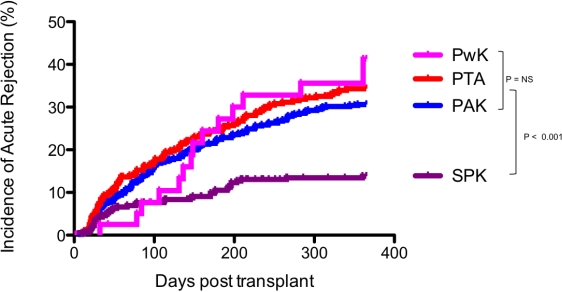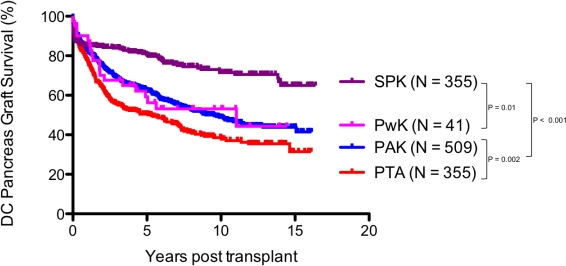Protective Impact of the Kidney in SPK Transplants – Mechanisms for Improved Outcomes Compared with Solitary Transplants.
Surgery, University of Minnesota, Minneapolis, MN.
Meeting: 2016 American Transplant Congress
Abstract number: 299
Keywords: HLA matching, Pancreas transplantation, Rejection
Session Information
Session Name: Concurrent Session: Clinical Pancreas Transplantation 1
Session Type: Concurrent Session
Date: Monday, June 13, 2016
Session Time: 4:30pm-6:00pm
 Presentation Time: 4:54pm-5:06pm
Presentation Time: 4:54pm-5:06pm
Location: Room 309
Purpose: Outcomes for SPK txps are superior to solitary pancreas txps. The basis for this difference is unknown. We sought to identify the biologic mechanism for the difference. Our hypothesis was that either the uremic conditions in a SPK txp or the immunoprotective influence of the kidney resulted in better graft survival.
Methods: Review of 1,260 pancreas txps (355 SPK, 509 PAK, 355 PTA, and 41 SLK [simult LD kidney and DD pancreas]) performed (1998-2015). Bivariate and multivariate methods were applied to txp outcomes accounting for a full panel of covariate risk factors. To determine whether the uremic conditions during the txp provided a protective effect we compared the risk of AR or graft loss between SPK and SLK txps, where both patients are uremic. To assess for the immunoprotective impact of the kidney, we examined HLA matching between prior kidney donor and the current pancreas donor for PAK txps.
Results: We found that SLK txps had a higher incidence of AR (p<0.001) and worse graft survival (p=0.01) than SPK. SLK txps had the same risk of AR and graft loss as PAK txps (p=NS). Furthermore, in MV models the risk of AR for either SLK txps or SPK txps was not different if the patient was or was not on HD prior to txp (HR 0.93, p=0.8, Fig. 1). Graft survival for SLK and PAK txps are nearly identical (p=NS), and together they are intermediate between SPK and PTA (Fig. 2). In MV models we found that >numbers of HLA matches between previous kidney and current pancreas resulted in improved graft survival (HR 0.825, p=0.029). Txps with 1-4 HLA-B and –DR matches were improved compared with those with 0 (p=0.05).
Conclusion: These data show the superiority of SPK txps is not due to the uremic conditions during the txp, but may be due to an immunoprotective influence of the matched kidney.


CITATION INFORMATION: Finger E, Dunn T, Kukla A, Kirchner V, Kandaswamy R. Protective Impact of the Kidney in SPK Transplants – Mechanisms for Improved Outcomes Compared with Solitary Transplants. Am J Transplant. 2016;16 (suppl 3).
To cite this abstract in AMA style:
Finger E, Dunn T, Kukla A, Kirchner V, Kandaswamy R. Protective Impact of the Kidney in SPK Transplants – Mechanisms for Improved Outcomes Compared with Solitary Transplants. [abstract]. Am J Transplant. 2016; 16 (suppl 3). https://atcmeetingabstracts.com/abstract/protective-impact-of-the-kidney-in-spk-transplants-mechanisms-for-improved-outcomes-compared-with-solitary-transplants/. Accessed December 28, 2025.« Back to 2016 American Transplant Congress
